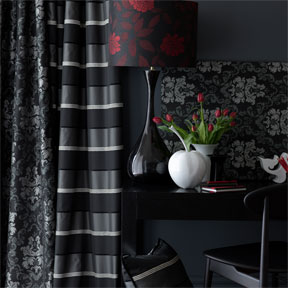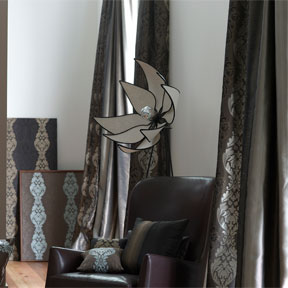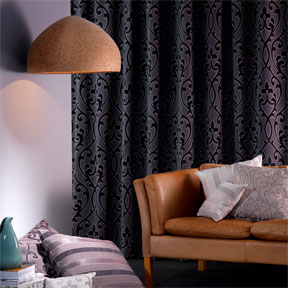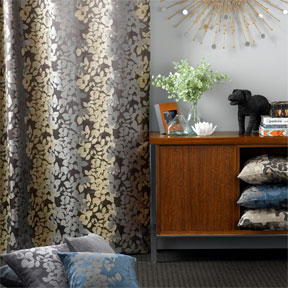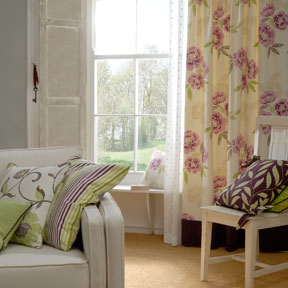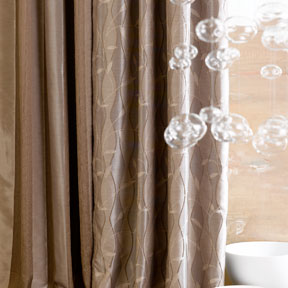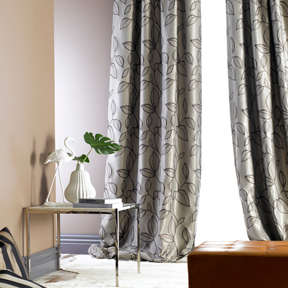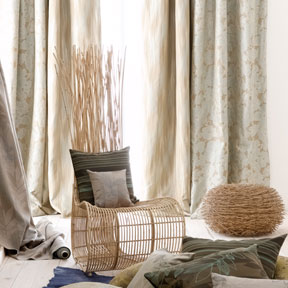Curtain F.A.Q.
What type of lining do I need?
There are many different types of linings available now, from polycotton, satin, polyester, thermal to block-out linings and linings to help block out noise.
- Polyester linings are useful if you have mildew problems
- Thermal linings have a single coating at the back of the lining
- Block-out linings have a triple coating at the back of the lining.
The triple coating consists of a white coating, black coating in the middle and an outer white coating.
When do you use block-out linings?
When you want to block out light coming into the room during the day and when you want extra insulation. Most of the heat transfer is through the hot air from the room coming in contact with the cold glass in your window.
There are new block-out linings on the market which have a better health factor, where the block out is between two layers of fabric and the dust from the coating doesn’t separate from the fabric, as with the thermal coated fabrics and linings.
Thermal coated fabrics are best avoided in bedrooms for babies and young children.
Should I choose coated or uncoated?
What is the coating? It is a chemical layer applied to the fabric as it goes through a coat-laying oven and a fairy layer is added to give it a fabric look. Uncoated fabrics are by far the better quality however some fabric designs are available coated and uncoated.
What is the difference between coated fabrics and uncoated fabrics?
Coated fabrics were invented to eliminate the need to attach a lining to a fabric. As the years went by, more coating was added to the fabric and less yarn, thus making the yarn layer very thin and the coating layer thicker for economy reasons. Therefore the cheapest fabrics are coated fabrics which have a thin layer of fabric and a thicker layer of coating.
Which fabrics are better?
Undoubtedly the uncoated ones, but they come at a slightly higher price and the cost of the lining has to be added. It is a matter of affordability. You can tell the quality of a fabric the same way you can tell the quality of a car; the more metal, the heavier the car. Older-style European woven fabrics, such as the Sanderson fabrics or fabrics made in England, Holland or Germany, were of high quality and lasted almost forever.
The economics of manufacturing shifted the textile industry to Thailand where the quality was still high. With more economy, the textile industry moved to China,Turkey and other Asian countries. The heavier the fabric, the more yarn it has and the better the quality. The earliest prints were made in England and Holland, before production moved toSouth Africa.
If you choose your fabric on the design only, the weight becomes immaterial and quality is secondary. Price doesn’t always match quality.
Ask your consultant about fabric quality and durability.
Fabrics can be plain or patterned
Fabrics follow fashion. Fifteen years ago, patterned fabrics were as common as plain fabrics, or more so. Then fashions changed and plain colours were far more prevalent than patterns. A lot of mills closed because they were geared to producing prints. The production of prints was either at the high end or low end and still evolving. Prints or plain fabrics are a personal choice. Sometimes you hear comments such as ‘I am not having that, that’s what my grandma would have’.
What is Jacquards?
Fabrics also come as ‘Jacquards’, named after the English inventor Joseph Jacquard in the 1800s. They tend to be good quality, heavier fabrics but this also depends on where they are made. Brocade and damask are types of jacquard woven fabrics.
How much is fabric?
Prices of fabrics range from $15 dollars per metre to $600 dollars per metre. If you choose to pay $600 per metre, ensure the fabric is hand-woven with every second thread from German silk and metal silver for reinforcement.
What type of material can I have?
Fabrics are made from the following materials:
- Cotton
- Polyester
- Viscose
- Silk
- Velvet
- Pure wool
Most material is a mixture of cotton and polyester. This mixture is good because the cotton gives weight and appearance and the polyester gives resistance to creasing and durability. Cotton and linen fabrics are good quality fabrics provided the cotton used is good quality. Well processed cotton lasts for a very long time
Polyester comes in many qualities – good quality polyester with some cotton mixture also lasts for a long time.
Viscose is offers a good thermal insulation and can achieve brighter colours (a matter of taste).
How can you tell if a fabric is a quality fabric?
First of all, where the fabric is made is a good indication. You can often tell the quality by the weight and feel of the fabric.
Does it have a fabric feel or a synthetic sheet feel? A fabric of lesser quality will crease more easily. If the fabric is creased on the roll, no matter how much you iron it the creases tend to remain even after the curtains have been hung.
How do you pay a fair price for a fabric? It is a personal choice as to whether you go for appearances or quality. For beautiful appearance, you will always pay more but quality and looks don’t always go together. Ask your consultant about the manufacturer, the material, the quality of the material, feel the weight of the fabric and above all arrange 2 or 3 quotes from reputable companies, such as Dial-A-Drape!
- Silk:
Silk is beautiful to look at but like Italian cars, it breaks down quickly – mainly from the UV sun rays. If you choose silk, our advice would be to use it in a shaded part of the house, well protected from the sun. It looks great, feels great and makes you feel like a million dollars, but the sun is its worst enemy.
- Wool:
Pure wool is rarely used in drapery for homes. It is what you would use in a naval vessel because of its flame retardant qualities.
- Velvet:
It was the sign of luxury in the bygone era, but hardly used now other than for stage curtains and some diehards. It is a fabric which offers good sound reduction at a cost. More fabrics are available with flame retardant properties built into them or they are dipped into flame retardant material. They burn and drip down instead of going up in flames. Flame retardant fabrics are mainly used in special applications, eg hospitals and schools.
- Soundproof fabrics:
Soundproof fabrics will reduce noise but will never provide 100% soundproofing. Velvet is good for soundproofing, the most effective being the more expensive types of velvet.

